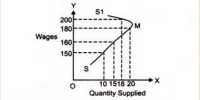In terms of production and supply, the long-run is the time period when there is no factor that is fixed and all aspects of production are variable and can therefore be adjusted to meet shifts in demand. Given a long enough time periods, a firm can take the following actions in response to shifts in demand:
- Enter an industry;
- Exit an industry;
- Increase its capacity to produce more; and
- Decrease its capacity to produce less.
In the long-run, a monopolistic ally competitive market is inefficient. It achieves neither allocates nor productive efficiency. Also, since a monopolistic competitive firm has power over the market that is similar to a monopoly, its profit-maximizing level of production will result in a net loss of consumer and producer surplus.
Setting a Price and Determining Profit
like monopolies, the suppliers in monopolistic competitive markets are price makers and will behave similarly in the long-run, Also like a monopoly, a monopolistic competitive firm will maximize its profits by producing goods to the point where its marginal revenues equal its marginal costs. The profit-maximizing price of the goodwill is determined based on where the profit-maximizing quantity amount falls on the average revenue curve.
While a monopolistic competitive firm can make a profit in the short-run, the effect of its monopoly-like pricing will cause a decrease in demand in the long-run. This increases the need for firms to differentiate their products, leading to an increase in average total cost. The decrease in demand and increase in cost causes the long run average cost curve to become tangent to the demand curve at the good’s profit-maximizing price. This means two things. First, that the firms in a monopolistic competitive market will produce a surplus in the long run. Second, the firm will only be able to break even in the long-run; it will not be able to earn an economic profit.
Long Run Equilibrium of Monopolistic Competition
In the long run, a firm in a monopolistic competitive market wills product a number of goods where the long run marginal cost (LRMC) curve intersects marginal revenue (MR). The price will be set where the quantity produced falls on the average revenue (AR) curve. The result is that in the long-term the firm will break even.












